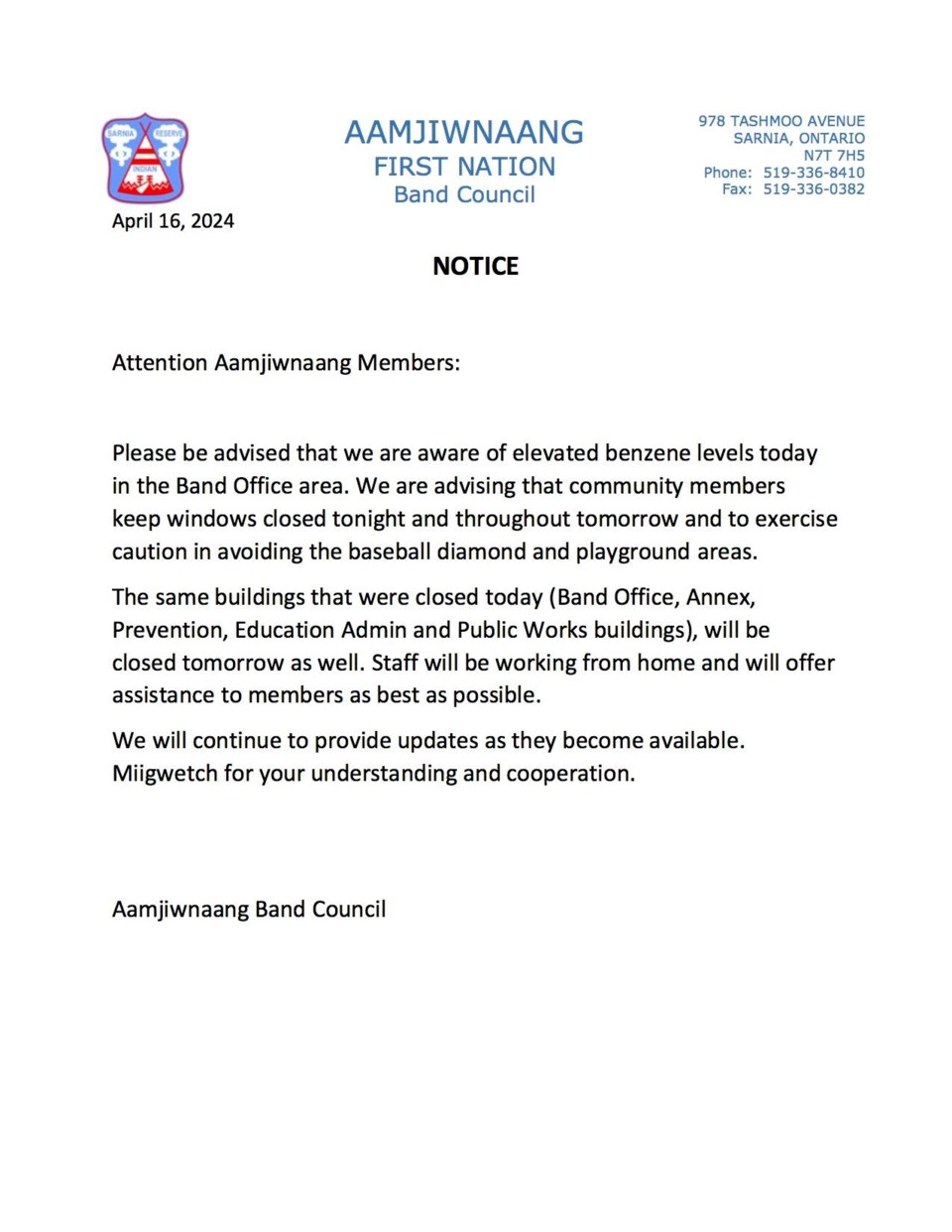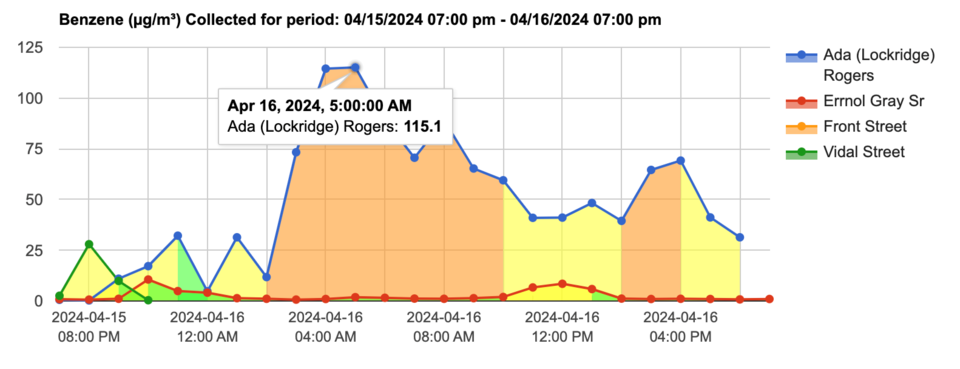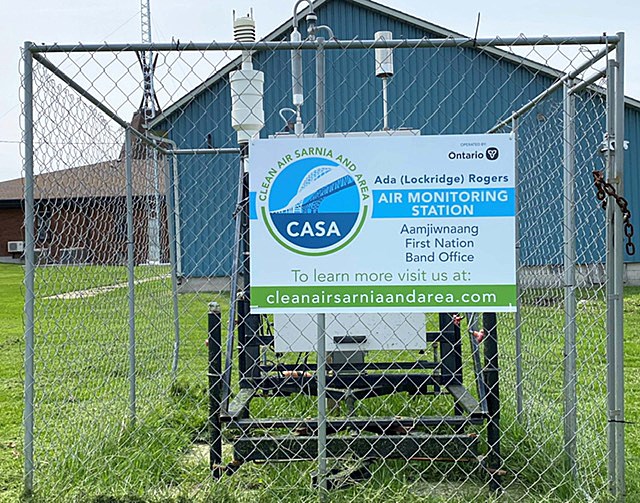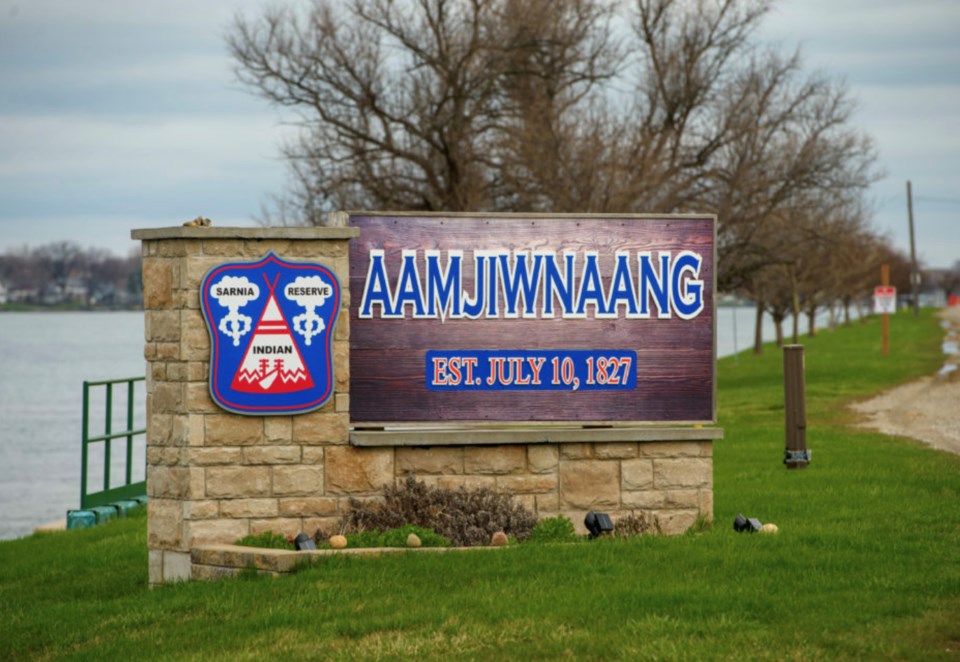Aamjiwnaang First Nation officials are calling for the immediate shut-down of the INEOS Styrolution Sarnia site, saying ‘extremely high’ levels of benzene are making residents sick.
In a news release issued late Tuesday, Aamjiwnaang Chief and Council expressed “extreme concern for the safety of community members” after Band employees complained of headaches, nausea and dizziness this week.
“The cause of these symptoms is directly related to the continuing and excessive levels of benzene emissions coming from the INEOS facility located directly across from the Band office, environmental office, and community playground (recreation area),” officials noted.

Earlier in the day, an alert issued through the Aamjiwnaang notification system notified residents that ‘extremely high’ levels of benzene prompted the closure of several buildings and sent staff home. Impacted buildings include the Band Office, Annex, Prevention Education Admin, and Public Works buildings.
Benzene is a volatile organic compound (VOC) that occurs naturally in crude oil. It is colourless, highly flammable, has a sweet odour, and is classified as a known carcinogen by the IARC (the International Agency for Research on Cancer).
No official emergency alerts were issued to the community through Lambton Alerts, which issues notices on behalf of local industry, and is administered by the Bluewater Association for Safety, Environment, and Sustainability (BASES).
"We are aware of the situation," BASES senior communications advisor Tracy Krull said in an email, "and are actively following up with local facilities to gather more information and understand if there are any current operational issues.”
No other information was provided.
Aamjiwnaang officials also told residents to keep windows closed and “exercise caution in avoiding the baseball diamond and playground areas.”

“The same buildings that were closed today will be closed tomorrow as well,” band officials noted.
Data from the Clean Air Sarnia Area (CASA) website showed benzene readings as high as 115 µg/m³, early Tuesday at the Ada (Lockridge) Rogers Monitoring station loaded near the Band Office. The Ministry air quality standard (24-hour Ambient Air Quality Criteria) for benzene is 2.3 µg/m³.

“Despite continuous fence line monitoring and oversight from both the provincial and federal governments, the level of benzene being reported within Aamjiwnaang’s monitoring stations continually exceeds regulated standards and more alarming appears to be increasing,” the news release noted. “The dangerous environment in which community members are forced to live and work are a direct result of colonialism and the continued oppression of Aamjiwnaang as a nation.”
The CASA website provides real-time data and air monitoring readings from nine stations operated by the Ministry of the Environment, Conservation and Parks, the Aamjiwnaang First Nation, and the Sarnia-Lambton Environmental Association. One of the newer stations is named after Ada Lockridge, a longtime environmental activist.

“It was really high Easter weekend too and [they] didn’t send any notification,” Lockridge told The Journal.
“When does the consciousness of provincial and federal governments awaken and move to action to implement immediate resolutions to stop the unregulated emissions of benzene?” Aamjiwnaang Chief and Council added in their statement, pointing to an “overwhelming breadth of study and independent research which calls on governments, to protect the health of Aamjiwnaang members.”
“Immediate reforms are needed to address the systemic racism which pervades the environmental protection regime and allows industry proponents, such as INEOS, to continue with ‘business as usual.’”
“Reconciliation should not perpetuate the historical power imbalance whereby Aamjiwnaang members’ lives are reduced to the point where the state can justify the emission of benzene levels which would not be tolerated anywhere else in Canada,” the statement added.
“In response to this latest environmental tragedy, Aamjiwnaang First Nation calls on federal, provincial, and municipal governments to immediately impose a shut down of the INEOS facility to remediate the ongoing benzene emissions and protect all community members.”
The Journal has reached out to the Ministry of the Environment, Conservation and Parks, INEOS Sarnia, and the City of Sarnia’s deputy fire chief/Community Emergency Management Coordinator (CEMC) Dale Gartshore, for comment.
